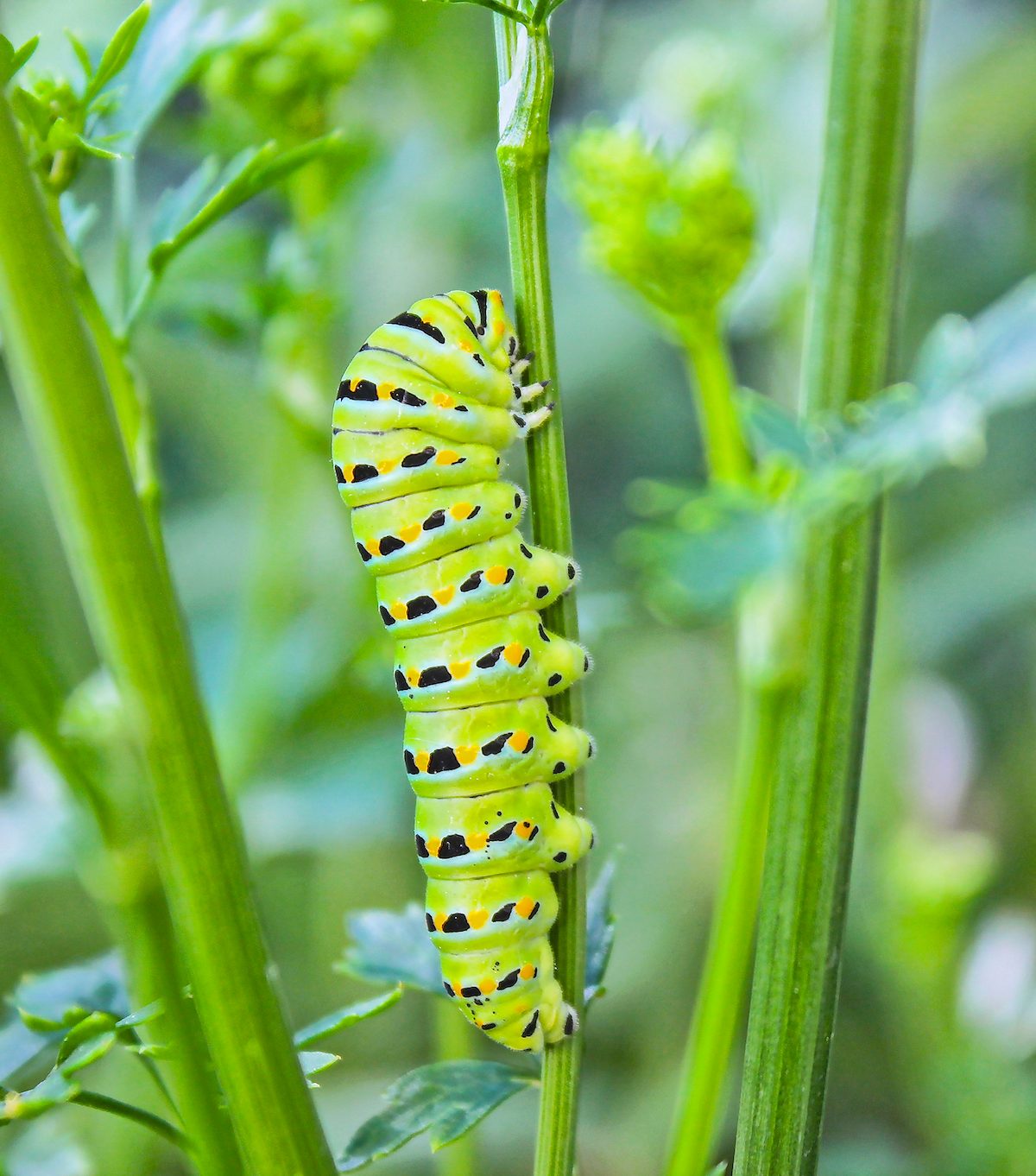Wondering if those eggs or caterpillars on your herb plants are pests or beneficial wildlife? Identify a parsley caterpillar and the butterfly it becomes.

What Type of Caterpillar Eats Parsley Plants?

On This Page
Does a Parsley Caterpillar Become a Butterfly?

Yes! The caterpillar most frequently found on parsley, dill, fennel, and related plants are the larval forms of the black swallowtail (Papilio polyxenes) butterfly. This species, sometimes known as a parsley caterpillar or parsley worm, lives throughout much of the United States, with the exception of the upper West and Pacific Northwest.
“Many people think ‘eeww!’ when talking about caterpillars and ‘wow!” when seeing butterflies, but don’t realize that you have to have the caterpillar to get the butterfly,” says Tia Silvasy, residential horticulture agent with UF/IFAS Extension Hillsborough County. Parsley caterpillars are a perfect example.
As the name suggests, these are large black butterflies with “tails” extending from the lower wings. Yellow, orange, and blue markings border the outer wings, and a small black dot in the orange spot of the lower hindwing helps distinguish this species from the lookalike spicebush swallowtail (Papilio troilus).
In parts of the West, especially from California to British Columbia, a caterpillar feeding on parsley, fennel, or dill might be of a related species, the anise swallowtail (Papilio zelicaon). It looks very similar to the black swallowtail larva: the youngest instars are black with a white band across the center, while the older instars are green, marked with stripes of black and yellow. However, the adult anise swallowtail has more yellow on the wings than the adult black swallowtail.
What Does a Parsley Caterpillar Look Like?

This is where things get a little tricky, because this caterpillar changes its appearance when it molts, or sheds its skin. Each instar (the time between molts) looks a little different from the last. You might see two very distinct caterpillars on your plant, one big and one small, looking completely unalike. Yet they’re both black swallowtail larvae!

Black swallowtail eggs look like tiny white or yellow pearls. The wee caterpillars that hatch out are black and spiky, with a white band across the middle. After their first molt, they’re a little bigger, but look much the same. At this stage, they resemble bird droppings—camouflage to keep them safe from predators.
In the third instar, parsley caterpillars begin to lose their spiky projections and develop more pronounced black, white, and yellow stripes. By the time they’ve molted into their fourth and fifth instars, the smooth larvae are green with white and black stripes marked with yellow dots, growing to a length of about 2 inches.
This whole process takes about two weeks. Then, the caterpillar forms its chrysalis, which is usually green or brown and resembles a leaf.
Are Black Swallowtail Caterpillars Poisonous or Toxic?
These caterpillars are generally safe to handle, even in their younger bristly instars. One thing to watch for is the osmeterium. This is a fleshy orange-yellow organ that black swallowtail caterpillars extend from their heads when they’re alarmed or threatened.
The osmeterium is covered in strong-smelling oils drawn from the foods the caterpillar eats. The foul odor usually drives predators away, and it can cling to your hands long after washing them, though it’s not harmful.
What Other Plants Do Black Swallowtail Caterpillars Eat?

“Parsley, dill, and fennel are well-known by gardeners as host plants for black swallowtail butterflies because they are commonly planted in herb gardens all over the U.S.,” says Tia. “In the wild, they use plants in the carrot family (Apiaceae) such as Queen Anne’s lace, water hemlock, parsnip, angelica, and anise. There are many larval host plants, so you can research which ones grow naturally in your USDA Hardiness Zone.”
Are Parsley Caterpillars Affected by Diseases or Parasites?

According to Tia, “In addition to the usual caterpillar predators like birds, spiders, and ants, black swallowtail larvae can fall prey to tachinid flies and parasitic wasps. They lay their eggs in the caterpillar and their larvae eat them from the inside out. The infestation often becomes apparent in the chrysalis stage, when tiny flies or wasps emerge from the chrysalis instead of a butterfly.”
This is a natural process, and helps keep populations in balance.
What If I Don’t Want a Caterpillar Eating My Parsley Plants?

Many people enjoy watching the life cycle of caterpillars into black swallowtail butterflies, but if you want to protect your herb garden from them, you have options.
“If they are eating too much and damaging your food crops, you may want to control them by hand picking,” Tia recommends. “We encourage gardeners to find a balance, and perhaps plant a few extra plants so the caterpillars can eat and so can you.”
“We grow two pots of dill, one for us and one for the eastern black swallowtail caterpillars. If they get on our stash, we simply place them on their own plant,” says Birds & Blooms reader Joseph Ackerman.
Do Monarch Caterpillars Eat Parsley?
Birds & Blooms experts Kenn and Kimberly say, “As with most other butterfly species, the caterpillars of monarchs have a specific diet, with only a few plants that they can eat. While they can dine on various species of milkweeds, they are not known to survive on any other plants. Parsley is a favored food plant for black swallowtail caterpillars, and it’s worth planting in a butterfly garden for that reason, but it won’t help the monarchs.”
About the Experts
Tia Silvasy is the residential horticulture agent with UF/IFAS Extension Hillsborough County, where she teaches residents about sustainable landscaping practices. She grew up on her family’s farm in Pittsburgh, Pennsylvania, and is passionate about gardening for wildlife and edible landscaping.
Kenn and Kimberly Kaufman are the official bird experts for Birds & Blooms. They are the creators of the Kaufman Field Guide series and they lead birding trips all over the world.





















